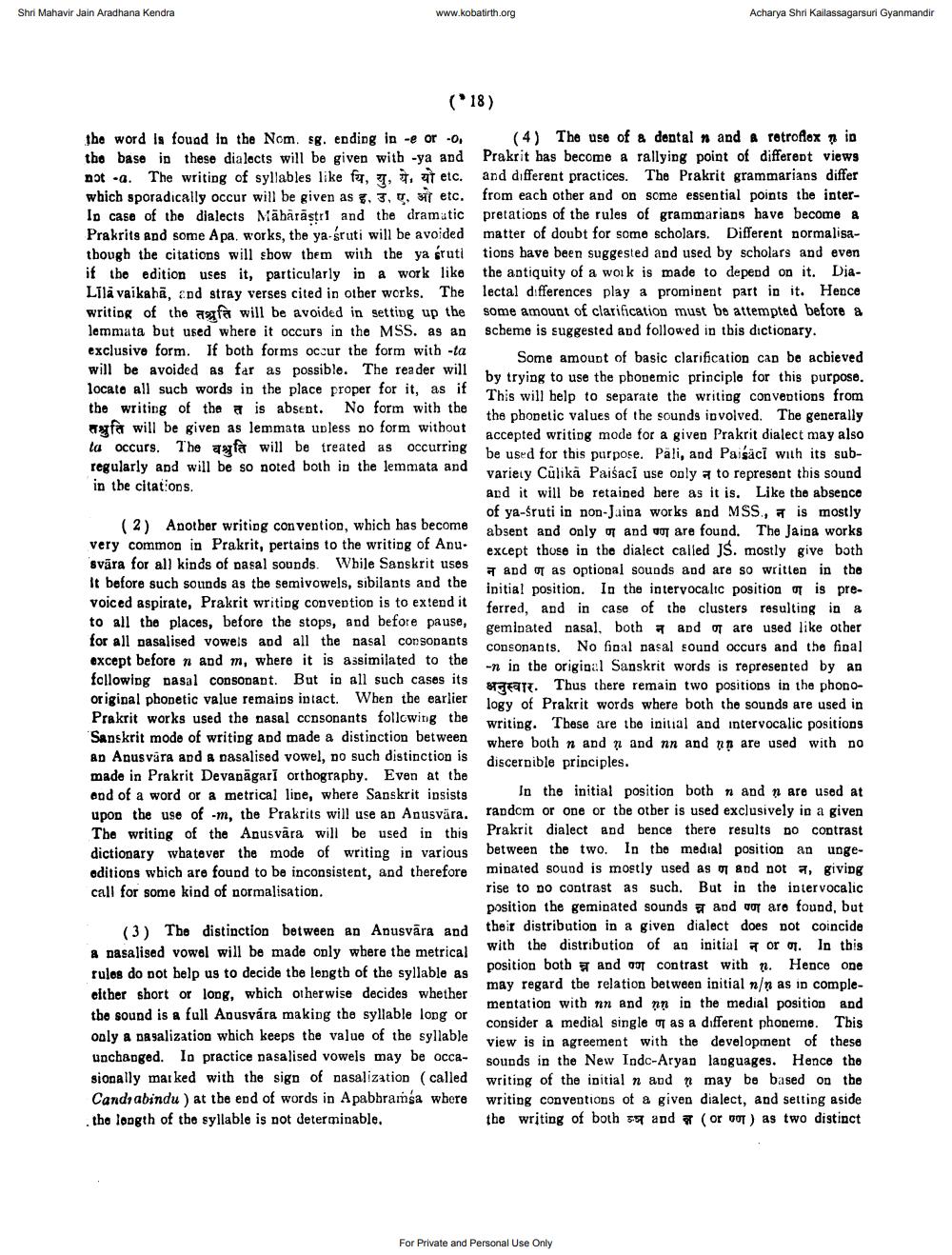________________
Shri Mahavir Jain Aradhana Kendra
www.kobatirth.org
(18)
the word is found in the Nom. sg. ending in -e or -0, the base in these dialects will be given with -ya and nota. The writing of syllables like far, यु. ये. यो etc. which sporadically occur will be given as g. 3, q, air etc. In case of the dialects Mähäräṣṭri and the dramatic Prakrits and some Apa. works, the ya-śruti will be avoided though the citations will show them with the ya gruti if the edition uses it, particularly in a work like Lila vaikaha, and stray verses cited in other works. The writing of the agfa will be avoided in setting up the lemmata but used where it occurs in the MSS. as an exclusive form. If both forms occur the form with -ta
will be avoided as far as possible. The reader will locate all such words in the place proper for it, as if the writing of the a is absent. No form with the afa will be given as lemmata unless no form without ta occurs. The agfa will be treated as occurring regularly and will be so noted both in the lemmata and
in the citations.
(2) Another writing convention, which has become very common in Prakrit, pertains to the writing of Anusvära for all kinds of nasal sounds. While Sanskrit uses It before such sounds as the semivowels, sibilants and the voiced aspirate, Prakrit writing convention is to extend it to all the places, before the stops, and before pause, for all nasalised vowels and all the nasal consonants except before n and m, where it is assimilated to the following nasal consonant. But in all such cases its original phonetic value remains intact. When the earlier Prakrit works used the nasal consonants following the Sanskrit mode of writing and made a distinction between an Anusvara and a nasalised vowel, no such distinction is made in Prakrit Devanagari orthography. Even at the end of a word or a metrical line, where Sanskrit insists upon the use of -m, the Prakrits will use an Anusvära. The writing of the Anusvara will be used in this dictionary whatever the mode of writing in various editions which are found to be inconsistent, and therefore call for some kind of normalisation.
(3) The distinction between an Anusvara and a nasalised vowel will be made only where the metrical rules do not help us to decide the length of the syllable as either short or long, which otherwise decides whether the sound is a full Anusvára making the syllable long or only a nasalization which keeps the value of the syllable unchanged. In practice nasalised vowels may be occasionally marked with the sign of nasalization (called Candrabindu ) at the end of words in Apabbramsa where the length of the syllable is not determinable.
Acharya Shri Kailassagarsuri Gyanmandir
(4) The use of a dental n and a retroflex ? in Prakrit has become a rallying point of different views and different practices. The Prakrit grammarians differ from each other and on some essential points the interpretations of the rules of grammarians have become a matter of doubt for some scholars. Different normalisations have been suggested and used by scholars and even the antiquity of a work is made to depend on it. Dialectal differences play a prominent part in it. Hence some amount of clarification must be attempted before a scheme is suggested and followed in this dictionary.
Some amount of basic clarification can be achieved
by trying to use the phonemic principle for this purpose. This will help to separate the writing conventions from the phonetic values of the sounds involved. The generally accepted writing mode for a given Prakrit dialect may also be used for this purpose. Pali, and Paisaci with its subvariety Culika Paiśacī use only a to represent this sound
and it will be retained here as it is. Like the absence of ya-śruti in non-Jaina works and MSS, is mostly absent and only or and or are found. The Jaina works except those in the dialect called JS. mostly give both
and or as optional sounds and are so written in the initial position. In the intervocalic position is preferred, and in case of the clusters resulting in a geminated nasal, both and or are used like other consonants. No final nasal sound occurs and the final -n in the original Sanskrit words is represented by an
. Thus there remain two positions in the phonology of Prakrit words where both the sounds are used in writing. These are the initial and intervocalic positions where both n and n and nn and np are used with no discernible principles.
In the initial position both n and are used at random or one or the other is used exclusively in a given Prakrit dialect and hence there results no contrast between the two. In the medial position an ungeminated sound is mostly used as of and not a, giving rise to no contrast as such. But in the intervocalic position the geminated sounds and our are found, but their distribution in a given dialect does not coincide with the distribution of an initial or 1. In this position both and or contrast with. Hence one may regard the relation between initial n/n as in complementation with nn and nn in the medial position and consider a medial single or as a different phoneme. This view is in agreement with the development of these sounds in the New Indc-Aryan languages. Hence the writing of the initial n and may be based on the writing conventions of a given dialect, and setting aside the writing of both and (or voT) as two distinct
For Private and Personal Use Only




